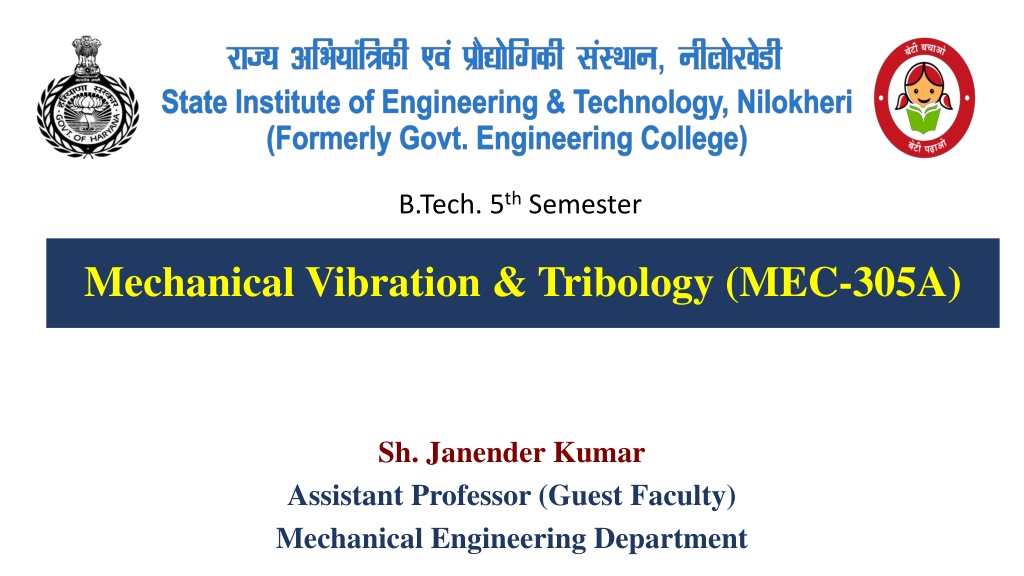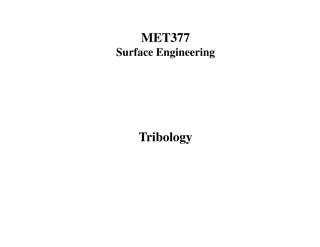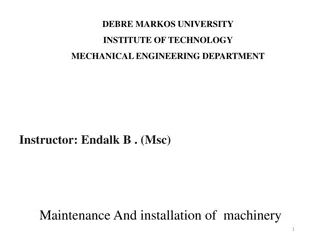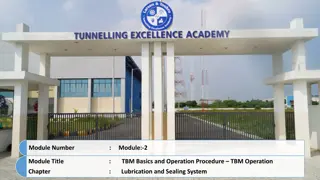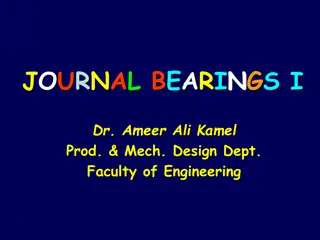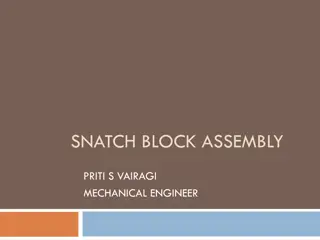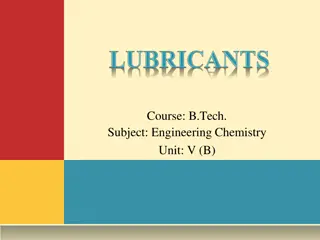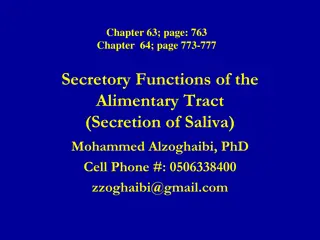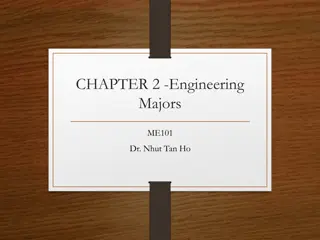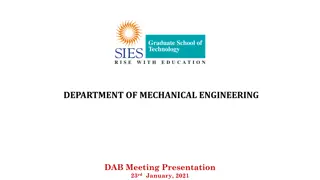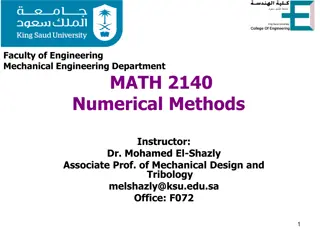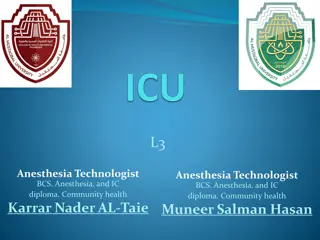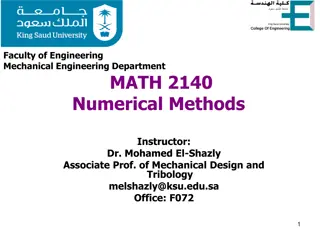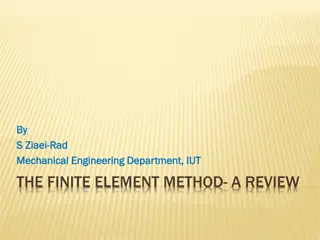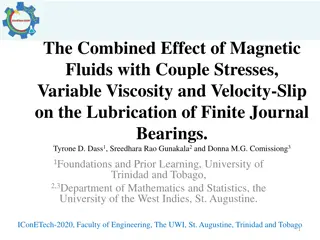Economic Aspects of Tribology and Types of Lubrication in Mechanical Engineering
Understanding the economic impact of friction and wear on machine parts is crucial to preventing costly failures in manufacturing industries. Implementing tribological strategies can help reduce these failures. The types of lubrication, such as boundary, hydrostatic, and hydrodynamic, play key roles in minimizing friction and ensuring smooth operation of mechanical components.
Download Presentation

Please find below an Image/Link to download the presentation.
The content on the website is provided AS IS for your information and personal use only. It may not be sold, licensed, or shared on other websites without obtaining consent from the author. Download presentation by click this link. If you encounter any issues during the download, it is possible that the publisher has removed the file from their server.
E N D
Presentation Transcript
B.Tech. 5th Semester Mechanical Vibration & Tribology (MEC-305A) Sh. Janender Kumar Assistant Professor (Guest Faculty) Mechanical Engineering Department
Economic Aspects of Tribology Economic Aspects of Tribology Friction and wear caused mechanical failure of machine parts. Resulting production stop and huge loss to the company. Reason, negligence of tribological aspects in the manufacturing industries and others. So we can reduce/stop these types of failures by implementing the strategies of tribology.
Lubrication Lubrication
Types of Lubrication Types of Lubrication 1.Boundary lubrication:- It is a thin film lubrication. Thickness of boundary film od oil between two metallic surfaces is typically 0.1 to 0.5 micron thick. Actually the film occasionally breaks by asperities of two surfaces and often metal to metal contact take place. This often exists at starting and stopping or when heavy load rotates at low speed or at high temperature when oil tends to squeezed out. As such boundary lubricants added with some boundary agents like fatty acids. - Coefficient of friction in boundary lubrication may vary from 0.08 to 0.2
-Boundary lubrication is the last guard against metal to metal contact. -it usually occurs at low speed and high load conditions in machine components such as cam, gears, bearing etc. 2.Hydrostatic lubrication:- -this is a thick film or full fluid film lubrication. -in this high pressure oil is supplied over the whole range of load and speed from external pump to separate the two surfaces by thick oil film. - In this type of lubrication, the friction is nearly zero. Coefficient of friction is only about 0.0001.
Hydrostatic lubrication Hydrostatic lubrication
As the load fully floats and the friction depends only on viscosity of oil. -however this principle is not used extensively in industries as it involves complicated oil pumping system, leak prevention system and collection devices which adds to space and cost of plant. 3.Hydrodynamic lubrication:- In this, a hydrodynamic pressure is gererated by relative movement of shaft in journal, dragging the viscous fluid into a taper film/wedge between the shaft and journal. -the pressure of this film becomes large enough to lift the rotating shaft
Hydrodynamic lubrication Hydrodynamic lubrication Radial pressure distribution in hydrodynamic lubrication
And physically separate the two surfaces by a film. The lubricanting films are normally thicker i.e 5-500 micron. 4.Elastrohydrodynamic lubrication:- This is a thick film or full fluid film lubrication. -this can be considered as extension of hydrodynamics lubrication. -the film thickness is thinner i.e 0.5-5micron than the conventional hydrodynamic lubrication. -EHD lubrication is most readily induced in heavily loaded contacts
[Such as m/c elements of low geometrical conformity]where loads act over relatively small contact areas , such as point contact of ball bearing and the line contact of roller bearing and gear teeth. In EHL, adhesive wear occurs during start and stop operations. Corrosive wear of bearing surfaces can also occur as a result of interaction with the lubricant. 5.Extreme pressure lubrication:- - When the sliding or moving surfaces are under high speed and high pressure in a system[automobiles] excessive heat is generated which produces high temperature. The high temperature thus produced at the rubbing surfaces change the physical and chemical characteristics of lubricant. It may get evaporated also. Consequently, lubricant becomes ineffective and fails to stick to rubbing metal surfaces.
In order to provide effective lubrication under high pressure and high temperature, additives are added to commonly used lubricants. The additive thus added are called extreme pressure additives and lubrication involved is termed as extreme pressure lubrication. -EPAs are chlorinated esters, sulphurised fats and oils. Extreme pressure additives provide efficient lubrication under extreme pressure conditions.
Selection of lubricants Selection of lubricants - Is done on basis of 1. High component life 2. Less number of failure 3. Longest drain interval 4. Easy availability 5. Low cost
Purpose of lubrication/functions Purpose of lubrication/functions Lubrication performs multiple functions, some of which are given below: 1. Reduce sliding and rolling friction for prolonging the life of parts and components, also to prevent wear. 2. Reduce electrical and mechanical power consumption. 3. Take away heat from components; work as a coolant. 4. Clean the parts to some extent by carrying away some of impurities or wear products to sump. 5. Reduce the noise, vibration and shocks between gear teeth and other comonents
